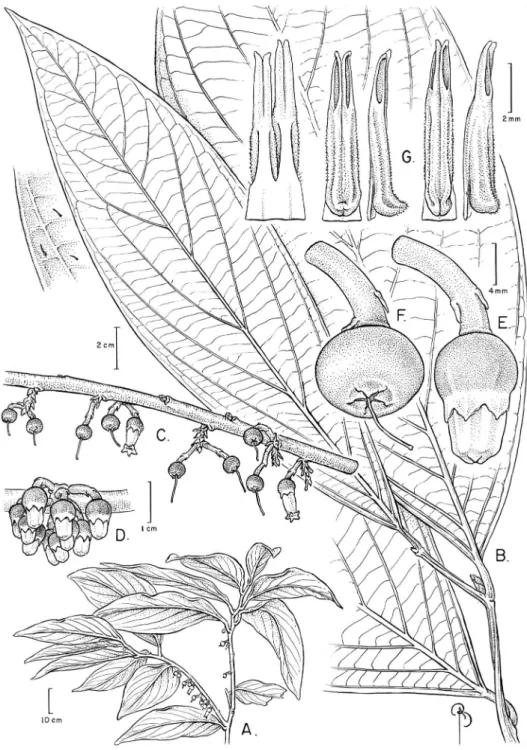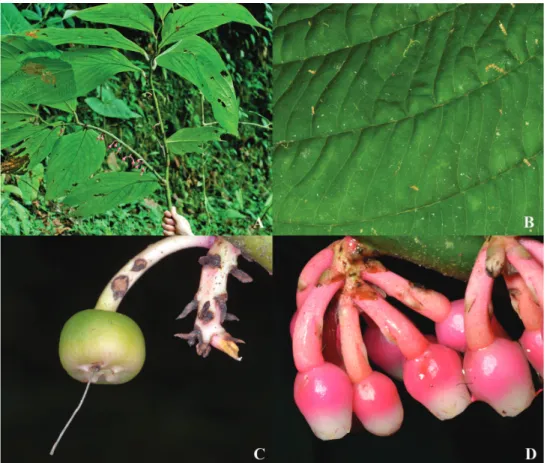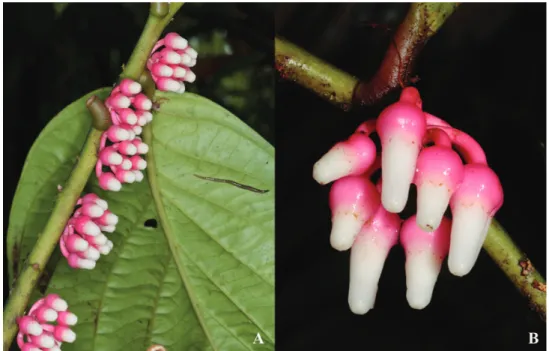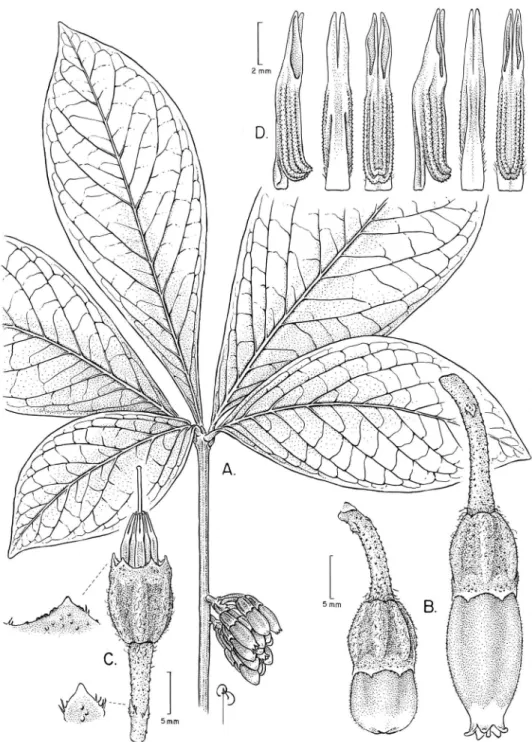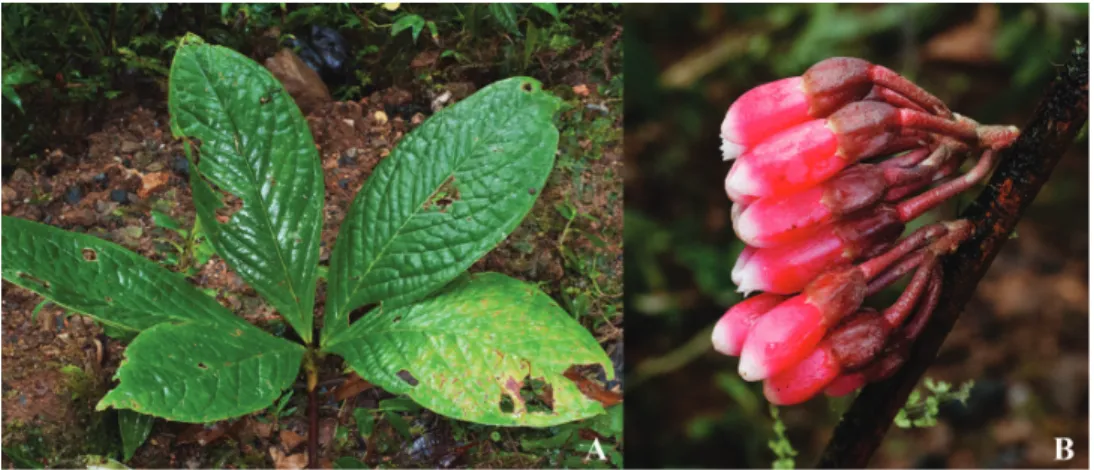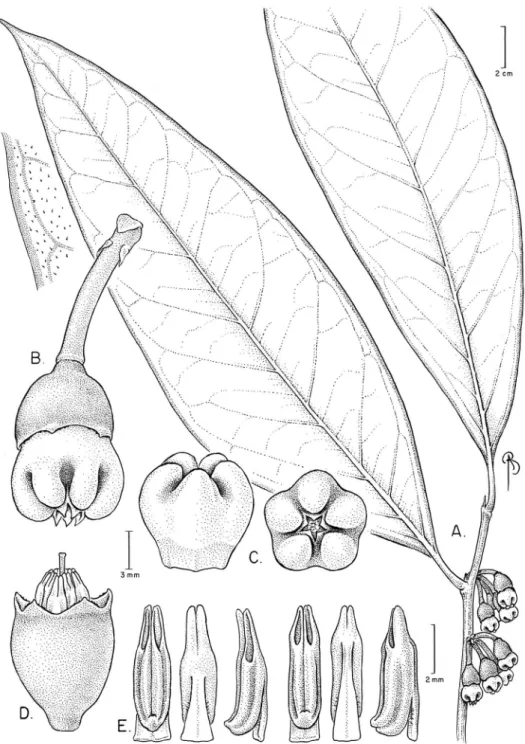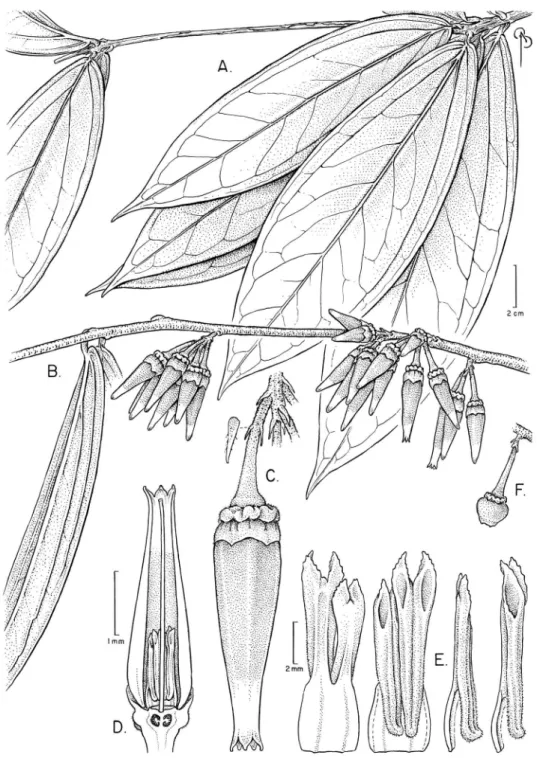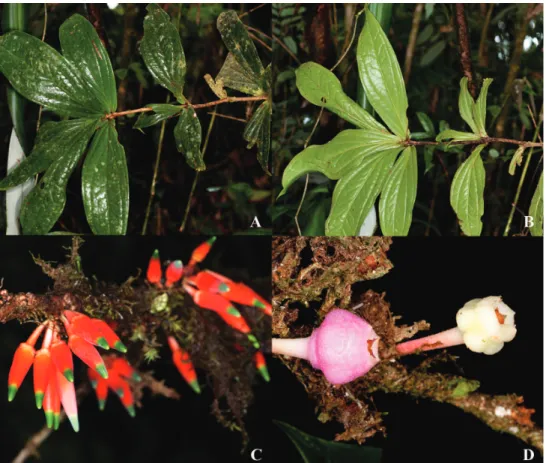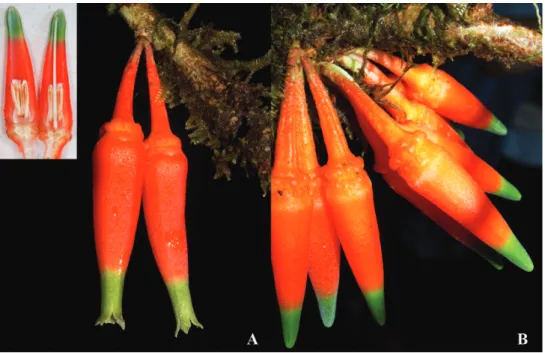New blueberry and
mortiño
relatives (Ericaceae)
from northwestern Colombia
Paola Pedraza-Peñalosa1
1 Institute of Systematic Botany, he New York Botanical Garden, 2900 Southern Blvd., Bronx, NY 10458
Corresponding author:Paola Pedraza-Peñalosa (ppedraza@nybg.org)
Academic editor:Sandra Knapp | Received 4 August 2014 | Accepted 15 April 2015 | Published 22 April 2015
Citation: Pedraza-Peñalosa P (2015) New blueberry and mortiño relatives (Ericaceae) from northwestern Colombia. PhytoKeys 49: 33–58. doi: 10.3897/phytokeys.49.8383
Abstract
he inventory of the vascular plants of one of the richest and least studied loras, the Andean and Chocó regions of northwestern Colombia, targets Las Orquídeas National Park. As a result of ield trips to areas never before collected, several epiphytic and small terrestrial shrubs in the family Ericaceae have been discovered in the Park’s humid forests. Five new, morphologically remarkable species of Ericaceae (tribe Vaccinieae), are here described and illustrated. In a separate phylogenetic analysis, Psammisia pinnata
Pedraza, P. pseudoverticillata Pedraza, Satyria orquidiensis Pedraza, and S. pterocalyx Pedraza, were placed by molecular sequence data within clades of the non-monophyletic genera Psammisia and Satyria; phylo-genetic evidence for the placement of P. sophiae Pedraza is still lacking. heir ainities are here discussed, along with their preliminary conservation status.
Resumen
El inventario lorístico de las plantas vasculares de una de las loras más ricas y menos estudiadas, los Andes y Chocó del noroccidente colombiano, se centra en el Parque Nacional Natural Las Orquídeas. Como resultado de trabajo de campo en áreas del parque nunca antes colectadas, se han descubierto varias especies epíitas y arbustivas de la familia Ericaceae, las cuales habitan los bosques húmedos de la reserva. Cinco nuevas especies de Ericaceae (tribu Vaccinieae), con peculiar morfología, son acá descritas e ilustradas. En un análisis ilogenético separado y basado en datos moleculares, Psammisia pinnata Pe-draza, P. pseudoverticillata Pedraza, Satyria orquidiensis Pedraza, y S. pterocalyx Pedraza, fueron asignadas a clados de los géneros no monoiléticos Psammisia y Satyria; para la asignación de P. sophiae Pedraza no hay evidencia ilogenética. Tanto las ainidades, como el estado preliminar de conservación de las nuevas especies, son acá discutidos.
http://phytokeys.pensoft.net
Copyright Paola Pedraza-Peñalosa. This is an open access article distributed under the terms of the Creative Commons Attribution License (CC BY 4.0), which permits unrestricted use, distribution, and reproduction in any medium, provided the original author and source are credited.
Paola Pedraza-Peñalosa / PhytoKeys 49: 33–58 (2015)
34
Keywords
Psammisia, Satyria, Vaccinieae, Chocó biogeographic region, Tropical Andes, Las Orquídeas National Park
Introduction
he Colombian Western Cordillera and adjacent Chocó region, which belong to the Tropical Andes and Chocó biodiversity hotspots (Mittermeier et al. 1998, Myers et al. 2000), respectively, have the highest angiosperm diversity in N South America (Morawetz and Raedig 2007). Despite their importance, entire lineages endemic to or particularly rich in western Colombia are missing in monographic and phyloge-netic works, as collections from this region have not been readily accessible, especially outside of the country. his unfortunate situation has silently weakened the scope of botanical research, while also undermining strategic planning for conservation and development in the Tropical Andes and the Chocó biogeographic regions, the world’s irst and ifth priority areas for conservation (Churchill et al. 1995, Mittermeier et al. 1998, Mast et al. 1999, Myers et al. 2000, Orme et al. 2005).
To bring attention back to one of the richest and least studied loras, an inven-tory of the vascular plants of Las Orquídeas National Park (LONP) was undertaken. LONP is strategically located in the conluence of the Tropical Andes and Chocó, in the Department of Antioquia (Colombia). Nested in the western slope of the Western Cordillera, LONP (29,118 ha; practically the same size of Grenada) boast an enor-mous altitudinal gradient (ca. 300–3,450 m) and consequent range of vegetation. In general, the forests below 2,000 m are considered to be part of the Chocó phytogeo-graphic region (Rangel-Ch. et al. 2004) while the remainder is Andean.
he ongoing inventory of the vascular plants of LONP particularly targets remote areas that have never been botanically explored before. In addition to trees, collecting is also focused on non-tree plants, especially those that are epiphytic and which are usually omitted from rapid loristic and vegetation assessments in the tropics. his holistic collecting strategy has resulted in the discovery of several new non-tree plant species, including ive members of the family Ericaceae, all placed in the berry produc-ing tribe Vaccinieae. hese ive new species are all restricted to the Colombian Western Cordillera and Chocó biogeographic region, and three of them are endemic to LONP. he new species are here described, illustrated, and discussed. heir preliminary con-servation status is also included, based on the author’s ield experience and knowledge of Colombian herbarium collections worldwide.
Vaccinieae diversity in Colombia
Ericaceae and the great majority belong to the inferior-ovaried tribe Vaccinieae (Lu-teyn 2002); actually, 27 genera are native to the Neotropics and all are Vaccinieae. he members of Vaccinieae are better known by the edible and commercially important blueberry, from North America, and the mortiño [Vaccinium loribundum Kunth], from South America.
In the Neotropics, the most extensive radiation of Ericaceae took place in Colombia with 24 genera and 278 species documented, that is ca. 35 % of the neotropical Ericace-ae. Notably, about 55 % of the Colombian species are endemic to the country (Pedraza-Peñalosa unpubl.). Within Colombia, the greatest diversity is found in Antioquia, where 18 genera and at least 116 species were recently documented (Pedraza 2011), before the discovery of the ive new species from LONP here described. Although Colombia contains already described hyper-diversity, its Ericaceae lora still remains poorly known, with many suspected undescribed species from sea level to the páramo.
Placement and phylogenetic affinities of new species
he taxonomic placement of new Vaccinieae is diicult due to the striking dispar-ity between generic-level phylogenetic relationships and current classiication systems (Kron et al. 2002, Powell and Kron 2003, Pedraza-Peñalosa 2009, 2010). herefore, to determine the generic placement of the new species, four were included in a com-prehensive phylogenetic analysis of neotropical Vaccinieae, based on chloroplast and nuclear sequence data of 91 species (Pedraza-Peñalosa et al. 2015). Unfortunately, am-pliications of the ifth new species (Psammisia sophiae Pedraza), which bears the most complex corolla structure, were not successful.
he molecular dataset was particularly rich in species of Satyria Klotzsch and
Psam-misia Klotzsch, both non-monophyletic and broadly deined groups, to which the ive
new species are initially assigned based on their overall morphology (Pedraza-Penalosa et al. 2015). However, the new species possess unusual characters for the genera in which they are provisionally placed: P. sophiae has a corolla morphology unique among neo-tropical Vaccinieae; P.pinnata Pedraza is among the few Psammisia s.l. with very large and pinnate leaves; P. pseudoverticillata Pedraza is the only species in the group with clustered leaves and one of the few with markedly angled calyces; S. orquidiensis Pedraza is the only species in the group with clustered leaves, while its calyx ribs and constrictions makes it one of two species of Satyria s.l. with ornamented calyces; and lastly, S. pterocalyx
Pedraza is the only other species in the group with ornamented calyx and apparently the only one with a corolla throat both dramatically constricted and elongated into a tube.
Eighteen out ca. 24 currently recognized species of Satyria s.l. were analyzed. he resulting best ML tree unequivocally placed the two new species described here, S.
orquidiensis and S. pterocalyx, within a group that comprises Satyria s.s.
Paola Pedraza-Peñalosa / PhytoKeys 49: 33–58 (2015)
36
he non-monophyletic Psammisia was split in the molecular analysis (Pedraza-Peñalosa et al. 2015). he largest of the groupings, Psammisia I clade, was dominated by species from the northern Andes. Psammisiapinnata and P. pseudoverticillata were both placed within one of its subclades, one mostly composed of Colombian species. All the species in this subclade share chartaceous to subcoriaceous leaves with pinnate vena-tion (the majority of Psammisia have plinerved and coriaceous leaves) and short racemes with a rachis typically less than 1.6 cm long, which give inlorescences a fasciculated appearance, their corollas are medium size (8–22 mm long). However, the molecular sequence data show that the newly described Psammisia are not closely related.
Unfortunately, at this time it is not known which clade in the Psammisia complex will retain the generic name, as P. falcata (Kunth) Klotzsch, the type species of the ge-nus has not been sequenced yet. hus, taxonomic and nomenclatural changes in
Psam-misia s.l. are anticipated. Moreover, because only 14 out of about 70 spp. of Psammisia
species were analyzed, a broader sampling of the group and related genera is needed to better infer the relationships of the new species described here. Names are coined here in order that they may be used in future studies both of phylogeny and conservation of Colombian plants.
New species from Las Orquídeas National Park (Colombia)
Psammisia pinnata Pedraza, sp. nov. urn:lsid:ipni.org:names:77146695-1 Figures 1–3
Diagnosis. Psammisia pinnata stands out among all other Psammisia s.l. because its distinctive large leaves (among the largest in the genus) that are subcoriaceous to chartaceous, elliptic to oblong, sometimes slightly asymmetrical, and which have pinnate venation; its petioles are pulvinate. Also distinctive is its ridged bark and conspicuous raceme rachises, and the relatively long lowers with staminal ilaments fused at their very base.
Type. COLOMBIA. Antioquia: Municipio Urrao. Corregimiento La Encar-nación, Parque Nacional Natural Las Orquídeas, camino entre el páramo del Almorza-dero y la cabaña de Calles, [6°31'N; 76°15'W. 1400 m], 31 Jul 2011 (l, fr) P. Pedraza-Peñalosa, J. Betancur, M. F. González, R. Arévalo, D. Sanín, A. Zuluaga, A. Duque & J.
Serna 2491 (holotype: COL!; isotypes: HUA!, E!, MO!, NY! [NY02058401]).
hairs except when indicated), apex acute, glabrous. Leaves alternate; petiole subterete, thick and basally pulvinate, 1–2.8 cm long, glabrous; lamina subcoriaceous to chart-aceous, elliptic to oblong, sometimes slightly asymmetrical (more evident in large leaves), (19–)23–45 × (5–)8.7–22 cm, base cuneate to sometimes nearly truncate, margin entire and eciliate except for the very young leaves with a handful of caducous apical hairs, apex (long or short) acuminate, glabrate with caducous hairs on both sides, adaxial hairs inconspicuous (< 0.5 mm long), abaxial hairs often aixed atop of what seem to be minute laminar glands; laminar glands only evident abaxially, dry-ing black, sparse, small, and round; venation pinnate, with up to 5 visible orders in dry specimens, 8–11 secondaries per side, these alternate (rarely subopposite), evenly dispersed along the lamina, ascending, brochidodromous, intersecondaries present toward midsection, midrib and secondaries adaxially impressed and abaxially raised, tertiaries well marked (in mature leaves), parallel among themselves and inserted at ca. 80–90° with respect to midrib. Inlorescence an axillary, solitary, 5–11-lowered raceme, often caulilorous; inlorescence bracts caducous, chartaceous, ovate, 1.2–1.8 × 1.7–3 mm, margin entire and eciliate, apex obtuse, glabrous on both sides, ve-nation obscure; rachis pink or magenta (fuchsia), 9–16 mm long, glabrous; loral bract 1, persistent, chartaceous, white, ovate, 1–3 × 1.5–2.5 mm, margin entire and eciliate, apex obtuse to acute, glabrous on both sides, venation obscure; pedicel pink or magenta (fuchsia), articulated with calyx, 9–23 mm long, glabrous; bracteoles 2, persistent, medially to distally inserted, opposite, chartaceous, white, ovate, 1.3–1.6 × 1–1.2 mm, margin entire and eciliate and with one or two pairs of stout masses of imbria, apparently glandular in nature, easily breakable, apex acute, glabrous on both sides, venation obscure. Flowers 5-merous, actinomorphic, diplostemonous. Ca-lyx pink or magenta, the lobes whitish with black marginal glands, cupuliform and sometimes slightly laring out apically (urceolate in vivo), 6–8.5 mm long, glabrous; tube cupuliform, terete, ca. 3.5 mm long; limb spreading when dry (erect in vivo), 3–4 mm long; lobes ovate, 1–1.8 × 2–3.5 mm long, glandular margin on each side of the lobe (excluding the apex) sometimes breaking into stout segments of fusing glandular imbria (sensu Luteyn 1983), margin eciliate, apex acute; sinuses obtuse (U-shaped); aestivation unknown. Corolla white (in bud basally pink and distally white), leshy, not bistratose, conic, terete, 17–22 mm long, ca. 4.5 mm diam., ca. 2.5 mm wide at throat, glabrous within and without; lobes ovate, 1.2–1.3 × 1.4–1.5 mm, apex acute; aestivation valvate. Stamens 10, equal (though one cycle very slightly shorter than the other by < 0.5 mm), 7–9 mm long, included, not adherent to co-rolla; ilaments connate in basal 0.3–1.5 mm, 3–4.7 mm long, glabrous, marginally glabrous or glabrate, the hairs inconspicuous, ca. 0.1 mm long; anthers 7–8 mm long, connective spurless; thecae 4.5–5 mm long, prognathous, without basal appendage, papillate; tubules 2, free, straight, basally similar in width to thecae, 2.2–3 mm long, smooth, dehiscing by introrse slits almost as long as the tubules, 2.2–2.7 mm long.
Ovary 5-locular; nectary not pulvinate, top of ovary lat or concave; style 17–20 mm
Paola Pedraza-Peñalosa / PhytoKeys 49: 33–58 (2015)
38
Figure 2.Psammisia pinnata. A Branches with leaves and inlorescences B Adaxial detail of leaf venation
C Immature fruit attached to inlorescence axis D Floral buds, lateral view. [Photos by P. Pedraza-Peña-losa (A–C) and Nelson R. Salinas (D).]
Distribution and ecology. Psammisia pinnata is restricted to the rich humid premontane and montane forests of the Colombian Western Cordillera (Antioquia, Risaralda, and Valle del Cauca) where it is known to lower and fruit in January, April, and July. It grows at 950–1900 m.
Etymology. he species name indicates the characteristic pinnate leaf venation. Preliminary conservation status.Psammisia pinnata occupies a large geographic area and ample altitudinal range, therefore there is no concern for its conservation status. However, it must be noted that Colombian Andes have alarming rates of de-forestation and transformation, putting its natural vegetation under constant threat.
Paola Pedraza-Peñalosa / PhytoKeys 49: 33–58 (2015)
40
Figure 3.Psammisia pinnata. A Immature inlorescences and abaxial side of leaf B Immature lowers. [Photos by P. Pedraza-Peñalosa (A) and Nelson R. Salinas (B).]
well-marked (abaxially) parallel tertiary venation, distinctively inserted at ca. 80–90° with respect to midrib (vs. not well-marked and reticulated); larger and fuller racemes with 5–11 lowers and rachises 9–16 mm long (vs. 2-lowered racemes and 2–4 mm long rachises [4–5-lowered fascicle in the protologue of P. multijuga]); glabrous caly-ces (vs. inconspicuously puberulous, the hairs eglandular and <0.5 mm long [glabrous in the protologue of P. multijuga]), with lobes with glandular margins (vs. eglandular); longer corollas (17–22 vs. 15 mm); basally connate staminal ilaments, 3–4.7 mm long (vs. free, 2–2.5 mm long); tubules 2.2–3 mm long, dehiscing by slits almost as long as the tubules (vs. tubules 4.3–4.6 mm long, dehiscing by short slits 1.5 mm long).
Specimens examined. COLOMBIA. Antioquia: Municipio Urrao, Corregi-miento La Encarnación, Vereda Calles, Parque Nacional Natural Las Orquídeas, inca de Alfonso Pino, entre la divisoria de las quebradas La Virola y El Bosque, al NW de la cabaña Calles, 6°31'35"N; 76°15'50"W, 1450–1470 m, 27 Jan 2011 (l, fr), P.
Pedraza-Peñalosa et al. 2015 [COL! (2 sheets), HUA, MO, NY! (2 sheets)]; Parque
Nacional Natural Las Orquídeas, sector Calles arriba, sitio El Macho, 6°32'22"N; 76°14'05"W, 1700–1750 m, 9 Dec 2013 (l), N. R. Salinas et al. 865 [COL, E!, HUA, LPB!, MO!, NY! (2 sheets)]; Near top of Cordillera Occidental on trail from Encar-nación to Parque Nacional Natural Las Orquídeas, 1900–2100 m, 27 Jan 1979 (l),
A. Gentry & A. Renteria 24641 (COL, MO!, NY!); Corregimiento Nutibara, region of
Murrí, Nutibara-La Blanquita road, 1700–1800 m, 19 Apr 1988 (l. buds), J. L.
J. L. Luteyn et al. 12110 (COL, NY!). Risaralda: Municipio Mistrató, Inspección de Policia de Jeguadas, camino entre Jeguadas y Puerto de Oro, entre los sitios Curramaí y Pisones, 1200–1500 m, 3 Abr 1992 (fr), J. Betancur et al. 3312 (COL, NY!). Valle del Cauca: Municipio Cali, Finca Zingara, km 18 de la carretera Cali-Buenaventura, km. 4 vía Dapa, Corregimiento La Elvira, 1900 m, 2 Abr 2000 (l), J. Giraldo-Gensini 903 (NY!).
Psammisia pseudoverticillata Pedraza, sp. nov. urn:lsid:ipni.org:names:77146696-1
Figures 4–6
Diagnosis. Psammisia pseudoverticillata can be easily diferentiated from all other
Psammisia s.l. by its leaves, which are clustered and seemingly verticillate, chartaceous,
large, obovate, bullate in vivo, pinnate, decurrent at the base, and subtended by a ba-sally pulvinated petiole. Its congested racemes bear lowers that are distinctive because of their large size, thickness and leshiness; however, it must be noted that the lowers of this new species shrink signiicantly upon drying. he lowers of P. pseudoverticillata
are also characterized by its color combination and angled calyces and corollas (calyces markedly angled).
Type. COLOMBIA. Antioquia: Municipio Urrao. Corregimiento La Encar-nación, Vereda Calles, Parque Nacional Natural Las Orquídeas, camino Calles-La Encarnación, después de la conluencia del Río Polo y el Río Calles, antes del Río San Pedro, sitio La Quiebra, 6°30'31"N; 76°14'W, 1600–1850 m, 31 Jan–2 Feb 2011 (l),
P. Pedraza-Peñalosa, J. Betancur, M. F. González, G. Giraldo, F. Gómez, A. Duque & J.
Serna 2134 (holotype: COL!; isotypes: HUA!, NY! [NY02058402]).
Description. Terrestrial shrubs with arching branches, < 1 m tall; stems and twigs somehow latten, caniculated lengthwise, apparently glabrous, the hairs inconspicu-ous (< 0.1 mm long), unicellular and eglandular (= minute hair type), bark brown and smooth. Axillary buds not observed. Leaves alternate, originated very close to-gether, pseudoverticillate with clusters of 3–5 leaves separated by lealess sections sev-eral centimeters long; petiole caniculate, basally pulvinate, 4–12 mm long, glabrate, minute type of hair; lamina chartaceous, bullate in vivo, obovate, (17.5–)20.5–24 × (6.5–)12–14.2 cm (at least 24 cm long, apices incomplete), base attenuate and decur-rent, margin entire and eciliate, apex missing in herbarium specimens but probably acuminate, glabrate on both sides, adaxially with caducous minute hairs, abaxially the hairs of arachnoid type, ca. 1 mm long, very thin, multicellular and eglandular; laminar glands absent; venation pinnate, with up to 4 orders visible adaxially in dry specimens, midrib adaxially impressed and abaxially raised, at least 9–11 secondaries per side, these alternate or subopposite, evenly dispersed along the lamina, ascending, adaxially lat and abaxially raised, brochidodromous, intersecondaries frequent.
Inlo-rescence an axillary, solitary, 6–8-lowered raceme; inlorescence bracts, loral bract,
Paola Pedraza-Peñalosa / PhytoKeys 49: 33–58 (2015)
42
Figure 4. Illustration of Psammisia pseudoverticillata. A Branch with clustered leaves and inlorescence
Figure 5.Psammisia pseudoverticillata. A Clustered leaves B Inlorescences, side view. [Photos by P. Pedraza-Peñalosa.]
Figure 6.Psammisia pseudoverticillata. A Branch with leaves and inlorescences B Close up of lowers showing the angled calyces. [Photos by P. Pedraza-Peñalosa.]
Paola Pedraza-Peñalosa / PhytoKeys 49: 33–58 (2015)
44
also covered with minute, whitish warts in vivo (inconspicuous when dried, though imparting rough look); pedicel red-brown, articulate with calyx, 12–14 mm long (17
mm in vivo), with the same indumentum and warts of the rachis; bracteoles 2, basal,
supopposite to alternate. Flowers 5-merous, actinomorphic, diplostemonous. Calyx red-brown, ellipsoid, 5-angled, the angles sharp and opposite to the sinuses, 8–9.2 mm long (10.5–11 mm in vivo), sparsely tomentulose with a combination of arachnoid and minute hair types, specially warty distally; tube ellipsoid, 6–7.4 mm long (8.5–9
mm in vivo); limb erect, 1.8–2 mm long; lobes deltate, 1 × 3.2 mm long, (1.5–1.7 × 4
mm in vivo), margin scariose (except at apex) and sometimes broken up in segments or
with a few multicellular and eglandular hairs, apex acute; sinuses obtuse (U-shaped); aestivation unknown. Corolla dark pink with white throat and lobes, very leshy, not bistratose, urceolate, 5-angled, 12–14 mm long (19 mm in vivo), 4–5.2 mm diam. (ca. 10 mm in vivo), 2.4–3 mm wide at throat (ca. 5 mm in vivo), puberulous without with a combination of arachnoid and minute hairs, the indumentum more abundant distally, glabrous within; lobes ovate, ca. 1.1 × 1.1 mm (ca. 2 × 2 mm in vivo), apex acute, relexed at maturity; aestivation valvate. Stamens 10, equal, 8.7–9 mm long, included, not adherent to corolla; ilaments free, long-triangular, 2.3–2.5 mm long, marginally glabrate, with minute hairs; anthers 8.3–8.5 mm long, connective spurless; thecae 4.1–4.5 mm long, slightly prognathous, without basal appendage, papillate; tubules 2, free, straight, 4–4.2 mm long, smooth, dehiscing by introrse slits, 2.7–3.5 mm long. Nectary not pulvinate, slightly concave in vivo, glabrous; style 15–17 mm long, included; stigma punctiform. Berry unknown.
Distribution and ecology.Psammisiapseudoverticillata is endemic to Antioquia (Colombia) and it is only known by the type specimen collected in Las Orquídeas Na-tional Park. It is known to lower in January and February. It grows in humid montane forests at 1600–1850 m.
where several Ericaceae novelties have recently been found (Pedraza-Peñalosa 2008), was identiied by James L. Luteyn as P. af. orthoneura. his specimen (Luteyn 12330) may belong to P. pseudoverticillata. However, the lowers are too immature to make an accurate identiication given slight diferences in leaf shape.
Psammisia sophiae Pedraza, sp. nov. urn:lsid:ipni.org:names:77146697-1 Figures 7, 8
Diagnosis.Psammisia sophiae difers from other Psammisia s.l. because of its extraor-dinary lowers of complex morphology and unusual color combination. he distal half of the globose corolla has ive pronounced projections or ribs, which in combination with the Christmas candy cane color pattern impart the species its distinctive and unique look.
Type. COLOMBIA. Antioquia: Municipio Urrao, Corregimiento La Encar-nación, Parque Nacional Natural Las Orquídeas, camino entre el páramo del Almor-zadero y la cabaña Calles, [6°31'N; 76°15'W, 1400 m alt], 31 Jul 2011 (l), P. Pedraza-Peñalosa, J. Betancur, M. F. González, R. Arévalo, D. Sanín, A. Zuluaga, A. Duque & J.
Serna 2490 (holotype: COL!; isotype: NY! [NY02058403]).
Paola Pedraza-Peñalosa / PhytoKeys 49: 33–58 (2015)
46
Figure 8.Psammisia sophiae. A Floral buds (top view) showing the distal ribs of the white corollas, which are magenta between the ribs B Top view of the inlorescence showing a lower at anthesis C Side view of the inlorescence showing a lower at anthesis D Branch with leaves, inlorescences and a detail of the pulvinate petioles. [Photos by P. Pedraza-Peñalosa.]
(10.5–11 mm in vivo), glabrous; tube cupuliform, terete, 5.5–5.8 mm long (7.8–8.5
mm in vivo); limb erect, 2–2.2 mm long (2–3.2 mm in vivo); lobes deltate, 1.1 × 2.5
Paola Pedraza-Peñalosa / PhytoKeys 49: 33–58 (2015)
48
but magenta between the ribs, from their bases up to the lobes sinuses, and continuing along the very margin of the lobes, the color pattern is such that when observed from the top, the corolla seem to have stripes with a color combination that is reminiscent of a Christmas candy cane, total corolla length 10 mm (7.5 mm long in immature low-ers), ca. 8 mm diam. (ca. 11 mm in vivo), ca. 2 mm wide at throat, glabrous within and without; lobes deltate, 1–1.5 × 1.5–1.6 mm, apex acute, slightly relexed; aestivation valvate. Stamens 10, equal, ca. 5.5 mm long, included, not adherent to corolla; ilaments free, triangular, 2–2.2 mm long, adaxially inconspicuously glabrate, abaxially glabrous; adjacent anthers difering moderately in width, ca. 5.2 mm long, the innermost with an incipient bump on each side of the connective; thecae 3.2–3.7 mm long, prognathous, without basal appendage, papillate; tubules 2, free, straight, 1.5–2 mm long, smooth, dehiscing by introrse slits almost as long as the tubules, 1.2–2 mm long. Ovary 5-locu-lar; nectary not pulvinate or evident, top of ovary completely lat; style ca. 7 mm long, included; stigma punctiform. Immature berry green, 8 mm diam.; seeds numerous, isodiametric, black when dry, with mucilaginous coat; embryo apparently white.
Distribution and ecology.Psammisia sophiae is endemic to Antioquia (Colombia) and it has only been collected in Las Orquídeas National Park. It is known to lower in December and July and fruit in January. It grows in conserved humid premontane forests at 1160–1400 m.
Etymology. Named after my daughter, Soia Varón, an equally beautiful bloom. Preliminary conservation status. Psammisia sophiae is only known from collec-tions made in Las Orquídeas National Park. Despite collecting in that protected re-serve for many years only a few specimens have been procured. his species seems to prefer conserved premontane forests. Currently, these forest, and the park in general, specially toward lower elevations, sufer from degradation product of human activities (agriculture, selective logging, livestock). I consider this species vulnerable due to the small area it occupies, its perceived scarcity, and current habitat threats.
Discussion. Although vegetatively similar, P. sophiae can be told apart from P.
panamensis, not only because of their strikingly dissimilar lowers (obconic, terete, and
with transversal bands of red, black and white in the latter), but also because the leaves
of P. panamensis are glabrous and when dried, the lamina has a black-bluish tint on
both sides (vs. hairs present, lamina drying brownish with a distinctive dark marginal band abaxially in P. sophiae), its petioles are not caniculate (vs. caniculate), and its rachis, bracts, bracteoles, and pedicel are longer.
Specimens examined. COLOMBIA. Antioquia: Municipio Frontino, Parque Nacional Natural Las Orquídeas, Finca La Guadalupa, Quebrada Horacio, aluente del Río Venados, 1160 m, 1 Dec 1986 (l), R. Callejas et al. 2937 (NY!). Municipio Urrao, Corregimiento La Encarnación, Vereda Calles, Parque Nacional Natural Las Orquídeas, cabaña Calles, 6°31'09.1"N; 76°15'08.4"W, 1357 m, 25 Jan 2011 (fr), P.
Pedraza-Peñalosa et al. 1951 (COL!, MO!, NY!); Corregimiento La Encarnación, Vereda Calles,
Satyria orquidiensis Pedraza, sp. nov. urn:lsid:ipni.org:names:77146698-1 Figures 9–11
Diagnosis.Satyria orquidiensis has many distinctive characters and it difers from other species in the genus because its leaves, which are clustered (up to 8 leaves) and seem-ingly verticillate (the only one in the genus), oblanceolate, large, and basally subcor-date. he abundant and large lowers of this new species also stand out because of the big ribs on the calyx tube and the sharp transversal constriction between the limb and tube, which gives the entire calyx a broad campanulate shape. he long obconic corolla (up to 4.4 cm long) is orange and green at the tip. Both calyx and corolla are covered with a ine glabrate indumentum.
Type. COLOMBIA. Antioquia: Municipio Urrao. Corregimiento La Encar-nación, vereda Calles, Parque Nacional Natural Las Orquídeas, inca de Alfonso Pino, en la divisoria de aguas entre las quebradas La Virola y El Bosque, al noroccidente de la cabaña de Calles, 6°31'35"N; 76°15'50"W, 1450–1470 m, 27 Jan 2011 (l, fr),
Paola Pedraza-Peñalosa et al. 2016 (holotype: COL!; isotypes, CAS!, CUVC, E!, HUA,
MO!, NY! [NY02058404], PSO).
Description. Epiphytic shrub, lianoid; stems brown-grey, terete, glabrous, bark smooth; twigs terete, smooth, glabrous. Axillary buds compressed; prophylls 2, val-vate, lanceolate, inconspicuous, 2.5–4.5 mm long, margin eciliate, apex acuminate, abaxially puberulous, the hairs inconspicuous, ca. <0.2 mm long, eglandular and uni-cellular (all indumentum composed of this type of hairs except when indicated). Leaves
Paola Pedraza-Peñalosa / PhytoKeys 49: 33–58 (2015)
50
Figure 10.Satyria orquidiensis. A Branch with clustered leaves, adaxial side B Branch with clustered leaves, abaxial side C Caulilorous inlorescences D Nearly mature (right) and immature fruits (left). [Photos by P. Pedraza-Peñalosa.]
2, basal, supopposite to opposite, chartaceous, ovate, 2–2.4 × 0.6–0.8 mm, margin entire and ciliolate, the hairs inconspicuous, caducous and eglandular, apex acumi-nate, glabrous on both sides, venation obscure. Flowers 5-merous (some calyces 6-mer-ous), actinomorphic, diplostemonous. Calyx dark or light orange, campanulate, with a marked transversal constriction between limb and tube, inconspicuously 5-angled, the angles alternating with lobes, conspicuously ribbed in the tube and with softer ribs in the limb, 4.1–5.8 mm long (6–7.2 mm in vivo), glabrate, the hairs inconspicuous, <0.1 mm long; tube oblate, 2–2.2 mm long (2.5–3 mm in vivo); limb slightly lar-ing, 2.1–3.6 mm long (3.5–4.7 mm in vivo); lobes deltate, 1–2 × 3.5–4.5 mm long (1.6–2 × 5 mm in vivo), margin entire, eglandular, and eciliate, apex acute; sinuses practically lat (broadly U-shaped in vivo); aestivation valvate. Corolla basal two thirds orange, apical third green, leshy, not bistratose, obconic, 3.2–4 cm long (3.4–4.4
cm in vivo), 1–1.2 cm diam. (1–1.1 cm in vivo), 3 mm wide at throat (4.7–5.5 mm
in vivo), inconspicuously 5-angled, glabrate without, the hairs inconspicuous, <0.1
Paola Pedraza-Peñalosa / PhytoKeys 49: 33–58 (2015)
52
tearing toward end of anthesis and the lobes then oblong and 4.8–7 × 1–2 mm, apex acute, not strongly relexed at maturity; aestivation valvate. Stamens 10, dimorphic, staminal cycles with diferent anther lengths and dehiscence orientation, included, not adherent to corolla. Long stamens 10–11.2 mm long; ilaments connate into a tube, straight, 3.5–4 mm long, glabrous or distally glabrate on the abaxial side, the hairs a handful, inconspicuous, multicellular and apparently eglandular; anthers 9–9.5 mm long, slightly prognathous, narrowing at base and widening at apex, without a clear distinction between tubules and thecae; thecae 6–6.5 mm long, without basal append-age, minutely papillate at least basally; tubules 2, free, turned inwards like bull’s horns, 3 mm long, smooth, dehiscing by latrorse elliptical slits 3 mm long, distal margin ornamented with small and irregular lobes. Short stamens 9–10 mm long, same shape, indumentum and features as long stamens except when indicated; ilaments 3.5–4 mm long; anthers 8–8.5 mm long; thecae 5.5 mm long; tubules pointing upwards and without space between them, 2.5–3 mm long, dehiscing by introrse elliptical slits 2.5–3 mm long. Nectary not pulvinate, slightly concave to lat, glabrous; style white, 2.6–3.7 cm long, included; stigma punctiform. Berry cream-colored and ribbed when immature, turning purple at maturity.
Distribution and ecology. Satyria orquidiensis is endemic to Antioquia (Co-lombia) and it only known from collections from Las Orquídeas National Park. It is known to lower in January and fruit in January and July. his species grows in the canopy of humid premontane and montane forests at 880-1470 m, but it is possible that it could be found at lower altitudes as well.
Etymology. Named after Las Orquídeas National Park (Colombia), where the species is endemic to.
Preliminary conservation status. Satyriaorquidiensis it is only known by speci-mens collected in Las Orquídeas National Park. It is commonly observed in conserved premontane and montane forests, but because it is a liana normally found high in the canopy, only a few collections exits. Because the observed abundance within the pro-tected area I consider this species of least concern.
Discussion. Morphologically, Satyria orquidiensis and S. pterocalyx stand out with-in the genus and have more similarities among themselves than with other species; these are the only species in the genus with conspicuous wings and/or ribs on their calyces. Although their large corollas share similar colors and obconic shape, they can be easily diferentiated because S. orquidiensis has corollas inconspicuously 5-angled (vs. terete in S. pterocalyx), orange with green lobes (vs. red-orange with the tube and lobes green-whitish) that gradually decrease in diameter toward the lobes (vs. dramati-cally constricted at the throat which is elongated into a tube ca. 8 mm long). Also, the dark or light orange (vs. light green) calyces of S. orquidiensis are conspicuously ribbed on the tube and sharply constricted between the limb and tube (vs. calyces 5-winged, tube with two basal lobes in each of the facets demarked by the wings, not transver-sally constricted). Vegetetatively, these two new species are even more distinct as S.
orquidiensis has leaves that are clustered and seemingly verticillate (vs. not clustered
in S. pterocalyx), larger [(14–)18.7–28 cm long vs. 14–18 cm], basally subcordate (vs.
obtuse or cuneate), apically acute to acuminate (long acuminate, acumen 1.8–2.8 cm long), and with inconspicuous basal laminar glands (vs. absent).
Specimens examined. COLOMBIA. Antioquia: Municipio Frontino, Vereda Venados Abajo, Parque Nacional Natural Las Orquídeas, sector Venados, sitio La Miquera, 6°32'28.1"N; 76°18'05.3"W, 1000–1030 m, 27 Jul 2011 (fr), P.
Pedraza-Peñalosa et al. 2436 [COL!, NY! (2 sheets)]; Municipio Frontino, Vereda Venados
Abajo, Parque Nacional Natural Las Orquídeas, sector Venados, sitio La Esperanza, cuenca de la quebrada Arenales, 6°42'06.8"N; 76°18'46.03"W, 880-920 m, 29 Jul 2011 (l), P. Pedraza-Peñalosa et al. 2447 (COL!, MO!, NY!).
Satyria pterocalyx Pedraza, sp. nov. urn:lsid:ipni.org:names:77146699-1 Figures 12, 13
Paola Pedraza-Peñalosa / PhytoKeys 49: 33–58 (2015)
54
Figure 13.Satyria pterocalyx. A Branch with leaves and lowers B Flowers at anthesis. [Photos by P. Pedraza-Peñalosa.]
the throat, which is then elongated into a tube ca. 8 mm long; the corolla is red-orange with the tube and lobes green-whitish.
Type. COLOMBIA. Antioquia: Municipio Urrao, Vereda La Magdalena, camino de herradura desde La Magdalena al Río Ocaidó, pasando por el Alto del Caballo, cuen-cas ríos Orougo, Orougito y Ocaidó, 6°14'05"–6°16'55"N; 76°13'24"–76°15'14"W, 1730–2150 m, 13 Dec 2007 (l), P. Pedraza-Peñalosa, J. Betancur, F. Gómez & O.
Laverde 1755 (holotype: COL!; isotypes: HUA!, MO!, NY!).
Paola Pedraza-Peñalosa / PhytoKeys 49: 33–58 (2015)
56
mm long (6.2–6.5 mm in vivo), 5-winged, the wings alternating with lobes, minutely puberulous; tube oblate, 3–3.2(–5.2) mm long (3.5–4.1 mm in vivo), the base conspicu-ously lobed, each facet of the calyx demarked by the wings contains two basal lobes that together look like an inverted m; limb more or less erect, 1.6–2(–2.5) mm long (2.4–3.3
mm in vivo); lobes deltate, 0.8–1 × 3–3.5 mm long (0.5–1.2 × 4–6 mm in vivo), margin
entire, eglandular, and eciliate, apex obtuse; sinuses obtuse (U-shaped) to almost lat; aestivation unknown. Corolla red-orange with the tube and lobes green-whitish, leshy, bistratose, obconic and noticeably constricted at the throat which is elongated into a tube (ca. 8 mm long), terete, 2.8–3(–4) cm long, 1.2–1.3 cm diam., 2.7–3 mm wide at throat (4 mm in vivo), inconspicuously puberulous without with a combination of hairs min-ute (< 0.5 mm long), eglandular and unicellular, along with a few hairs eglandular and multicellular, glabrous within; lobes deltate, 1.1 × 1.2–1.5 mm (lanceolate, 4.3 × 2 mm
in vivo), apex acute, not strongly relexed at maturity; aestivation unknown. Stamens 10
(all measurements in vivo), dimorphic, staminal cycles with diferent anther lengths and dehiscence orientation, included, not adherent to corolla. Long stamens 9.8–10.8 mm long; ilaments connate at base, straight, 3–4 mm long, glabrate, the hairs inconspicuous and eglandular, the marginal ones unicellular, the abaxial ones multicellular, very scarce and distally concentrated, adaxial side glabrous; anthers 8.6–10.1 mm long, narrowing at base and widening at apex, without a clear distinction between tubules and thecae; thecae 5.9–7.1 mm long, without basal appendage, papillate at base, smooth at apex; tubules 2, free, pointing upwards, 2.5–3 mm long, smooth, dehiscing by latrorse ellipti-cal slits 2.2–2.5 mm long, abaxial side and margin ornamented with irregular epidermal projections. Short stamens 8.3–9.5 mm long, same shapes, indumentum and features as long stamens except when indicated; ilaments 3–3.5 mm long; anthers 7.5–9.4 mm long; thecae 5.2–6.4 mm long; tubules 2.3–3 mm long, dehiscing by introrse elliptical slits 2.2–2.5 mm long. Nectary pulvinate, not too prominent, glabrous; style 2.8–3.2 cm long, included; stigma discoid. Berry unknown.
Distribution and ecology.Satyriapterocalyx is restricted to the biologically rich montane forests of Western Colombia (Antioquia, Choco). It is known to lower in December and January.
Etymology. Species named after the rare winged calyces.
Preliminary conservation status. Satyria pterocalyx is known from two locali-ties far apart (from adjacent departamentos) that confer it a not so small geographic range. However, after botanizing for several years in Antioquia, this species remains only known by two individuals. Although collected a few miles from Las Orquídeas National Park, S. pterocalyx has not been found within the protected area. Currently, Colombian montane forest sufer from degradation product of human activities (ag-riculture, selective logging, livestock, mining, etc.), therefore I consider this species vulnerable due to its perceived scarcity and current habitat threats.
Discussion. he morphological diferences and similarities between Satyria
ptero-calyx and S. orquidiensis are discussed under the latter.
Acknowledgments
I am grateful to the National Science Foundation for supporting ield work related to this project (Grant number: NSF DEB-10206230, Vascular Plants of Las Orquideas National Park). I thank Parques Nacionales Naturales de Colombia, all the staf of Las Orquídeas National Park, and most particularly to Héctor Velásquez, Javier Serna and Arely Duque for their continued logistical support, work and invaluable help during every ield expedition. I am also grateful to the Herbario Nacional Colombiano, In-stituto de Ciencias Naturales, and particularly to Julio Betancur and Carlos Parra for supporting all the logistic and research activities in Colombia, as well as facilitating the study of herbarium vouchers in NY. Lastly, I must also thank the project’s research assistants, María Fernanda González, Elizabeth R. Tineo and Mateo Jaimes for their assistance processing the collections and work during ieldwork.
References
Churchill SP, Balslev H, Forero E, Luteyn JL (Eds) (1995) Biodiversity and conservation of neotropical montane forests. he New York Botanical Garden, New York, 702 pp. Kron KA, Powell EA, Luteyn JL (2002) Phylogenetic relationships within the blueberry tribe
(Vaccinieae, Ericaceae) based on sequence data from matK and nuclear ribosomal ITS regions, with comments on the placement of Satyria. American Journal of Botany 89: 327–336. doi: 10.3732/ajb.89.2.327
Luteyn JL (2002) Diversity, adaptation, and endemism in neotropical Ericaceae: Bio-geographical patterns in the Vaccinieae. he Botanical Review 68(1): 55–87. doi: 10.1663/0006-8101(2002)068[0055:DAAEIN]2.0.CO;2
Mast RB, Rodríguez-Maecha JV, Mittermeier RA, Mittermeier CG (1999) Tropical Andes. In: Mittermeier RA, Robles-Gil P, Mittermeier CG (Eds) Hotspots: Earth’s Biologically Rich-est and Most Endangered TerrRich-estrial Ecoregions. CEMEX, Mexico, 68–85.
Mittermeier RA, Myers N, homsen JB, de Fonseca GAB, Olivieri S (1998) Biodiversity hot-spots and major tropical wilderness areas: approaches to setting conservation priorities. Conservation Biology 12(3): 516–520. doi: 10.1046/j.1523-1739.1998.012003516.x Morawetz W, Raedig C (2007) Angiosperm biodiversity, endemism and conservation in the
Neotropics. Taxon 56(4): 1245–1254. doi: 10.2307/25065916
Myers N, Mittermeier RA, Mittermeier CG, da Fonseca GAB, Kent J (2000) Biodiversity hot-spots for conservation priorities. Nature 403: 853–858. doi: 10.1038/35002501
Orme CDL, Davies RG, Burgess M, Eigenbrod F, Pickup N, Olson VA, Webster AJ, Ding T, Rasmussen PC, Ridgely RS, Stattersield AJ, Bennett PM, Blackburn TM, Gaston TM, Owens IPF (2005) Global hotspots of species richness are not congruent with endemism or threat. Nature 436: 1016–1019. doi: 10.1038/nature03850
Bio-Paola Pedraza-Peñalosa / PhytoKeys 49: 33–58 (2015)
58
diversidad y Recursos Naturales. Universidad de Antoquia, Missouri Botanical Garden & Oicina de Planeación Departamental de la Gobernación de Antioquia, D’Vinni, Bogotá, 448–460.
Pedraza-Peñalosa P (2008) hree New Species of Disterigma (Ericaceae: Vaccinieae) from west-ern Colombia, with comments on morphological terminology. Brittonia 60: 1–10. doi: 10.1007/s12228-008-9006-3
Pedraza-Peñalosa P (2009) Systematics of the neotropical blueberry genus Disterigma (Eri-caceae). Systematic Botany 34: 406–413. doi: 10.1600/036364409788606352
Pedraza-Peñalosa P (2010) Insensitive blueberries: a total evidence analysis of Disterigma s.l. (Ericaceae) exploring transformation costs. Cladistics 26: 388–407. doi: 10.1111/j.1096-0031.2009.00293.x
Pedraza-Peñalosa P, Salinas NR, Virnig ALS, Wheeler WC (2015) Preliminary phylogenetic analysis of the Andean clade and the placement of new Colombian blueberries (Ericaceae, Vaccinieae). PhytoKeys 49: 13–31. doi: 10.3897/phytokeys.49.8622
Powell EA, Kron KA (2003) Molecular systematics of the northern Andean blueberries (Vac-cinieae, Vaccinioideae, Ericaceae). International Journal of Plant Sciences 164: 987–995. doi: 10.1086/378653
